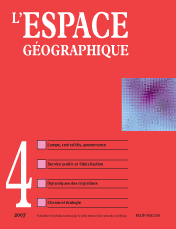

The core and the periphery of the European space: empirical analysis of the concentration and diffusion of activities (4 fig., 4 tabl.)
This article presents an empirical analysis of the transformations of the European regional space, especially the agglomeration of economic and research activities and sectoral specialisations in “central” and “peripheral” regions. In particular, this paper shows that the growing concentration of industrial activities has not taken place at the expense of peripheral regions (although there has been increased intensity of specialisation) and that the concentration of the research effort, biased in favour of central regions, has decreased slightly in the two last decades.
keywords: CENTRALITY, REGIONAL INTEGRATION, SECTORAL SPECIALISATION, TECHNOLOGICAL DIFFUSION
Polycentrism and governance in the Central Belt, Scotland (4 fig., 1 tabl.)
This article looks at polycentrism, recent or historical, on the scale of the Central Belt. Polycentrism on the metropolitan scale can be proven historically in the Glasgow region, but it has never really existed in either Edinburgh or the Central Belt area that separates it from Glasgow. The historical background of the two cities reveals a population expansion that differs in every way political, cultural and economic and that has given rise to a tradition of competition between the two cities. Successive boundary changes have redrawn the Scottish institutional landscape, intensifying this competition, while at the same time untying the historical links that had formed between the two cities and their neighbouring towns.
keywords: EDINBURGH, GLASGOW, GOVERNANCE, POLYCENTRISM, REGIONALISATION
A geography of public air services in Europe (1 encadré, 7 fig., 4 tabl.)
Public service obligations (PSO) play only a marginal role in European air transport supply. However, some regions would be largely, if not completely, devoid of an air service without this support mechanism. The geography of PSOs does not follow an EU logic because Member States are competent in this field. It reflects a mix of (local or national) activism and public responsiveness. A focus on the French case shows that today’s PSOs reflect a remodelled geography in comparison to the subsidised air links of the 1970s and 1980s.
keywords: AIR TRANSPORT, EUROPEAN UNION, LIBERALISATION, PUBLIC UTILITIES
Intra-urban residential mobility in Bogotá: intermediate levels of modelling (5 encadrés, 5 fig., 1 tabl.)
This paper proposes a model of intra-urban residential mobility and its impact on social and spatial change in the city, which encompasses several factors: the demographic trend of life cycle and social mobility; the changing housing stock; and the economic factor of the housing market. The approach taken is a compromise between an aggregate approach, which accounts for change in the population distribution and reconfigurations of the city and an individual approach, which stresses the causes and impact of residential choices on intra-urban mobility.
keywords: BOGOTÁ, DYNAMIC MODELLING, LEVELS OF ABSTRACTION, RESIDENTIAL MOBILITY, SOCIAL STRUCTURE
Balkan workers in Greece: economic migration or regional circulation? (1 encadré, 7 fig., 4 tabl.)
For more than ten years, Greece has been one of the EU countries with the highest ratio of immigrants. As the last census shows, they account for up to 7% of the total population. These foreigners mostly come from Albania (57%), and in smaller numbers from Bulgaria (5%) and Romania (2.9%). They are given low-paid, unattractive jobs rejected by nationals. These ratios also include seasonal migration of workers entering Greece for only a few months a year. An examination of these flows highlights the way the social relationships influence migration networks.
keywords: BALKANS, GREECE, MIGRATION, MIGRATORY RESOURCE
Suburban forest nature reconstructed by city? The example of hunting activity at Strasbourg and Karlsruhe. (3 fig., 1 tabl.)
Through their social functions, suburban forests are now considered essential and complementary to the urban environment. Municipalities that own them often try to apply a management model that meets the population’s expectations. However, these expectations are often dictated by an idealistic view of the forest, which fails to take real management issues into account. By revealing hunting activity in suburban forests, this article attempts to highlight the different issues at stakes in these new “urban territories”, focusing on the examples of two culturally different cities: Strasbourg in France and Karlsruhe in Germany.
keywords: HUNTING, MANAGEMENT, REPRESENTATION, SUBURBAN FOREST, TERRITORY
Book reviews
In this issue of l’Espace géographique, you will find critical reviews of the following books
LONGHURST R. (2000). Bodies. Exploring fluid boundaries. Londres, New York: Routledge, 176 p. (Anne Fournand, université de Genève)
MOSS P., DYCK I. (2002). Women, body illness. Space and identity in the everyday life of women with chronic illness. New York: Rowman an Littlefield Publisher, 244 p. (Anne Fournand, université de Genève)
NELSON L, SEAGER J. (2004). A Companion to Feminist Geography. États-Unis: Blackwell, 640 p. (Anne Fournand, université de Genève)
SALOMON-CAVIN J. (2005). La Ville mal aimée. Représentations anti-urbaines et aménagement du territoire en Suisse: analyse, comparaisons, évolution. Lausanne: Presses polytechniques et universitaires romandes, coll. «Logiques territoriales», 238 p. (Béatrice Bochet, université de Lausanne)
KÜBLER D. (2005). La Métropole et le citoyen. Les agglomérations urbaines en Suisse vues par leurs habitants. Lausanne: Presses polytechniques et universitaires romandes, coll. «Logiques territoriales», 166 p. (Jean-Bernard Racine, université de Lausanne)
CABANNE C., TCHISTIAKOVA E., (2005). La Russie, perspectives économiques et sociales. Paris: Armand Colin, coll. «U Géographie», 304 p. (Denis Eckert, CNRS Toulouse)
L’espace géographique 3/07![]()
![]() L’espace géographique 1/08
L’espace géographique 1/08
For subscribe or buy this issue: BELIN
![]() L’Espace géographique: contents
L’Espace géographique: contents
Last modified: October 22, 2007